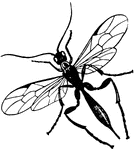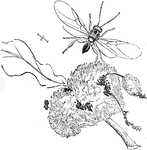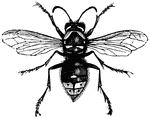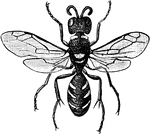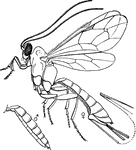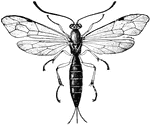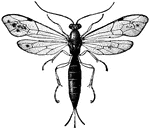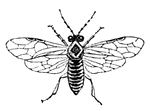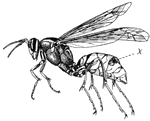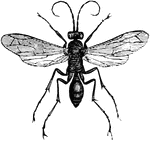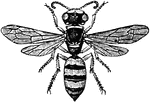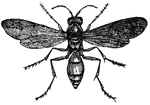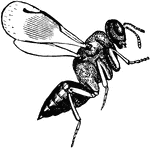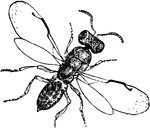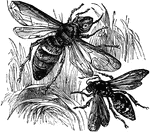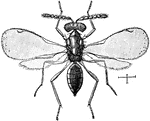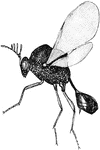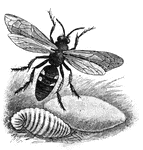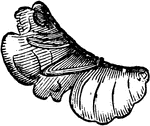This ClipArt gallery offers 197 pictures of numerous insects from the order Hymenoptera, including ants, bees, wasps, hornets, sawflies, and ichneumon.
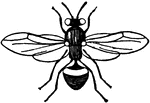
Gall-fly
Gall-fly is a name applied to the members of the family Cynipidae, which are not flies, but are related…
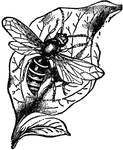
Hornet
"Hornet is the largest species of wasp found in America. The thorax is mostly black; the abdomen is…

Hornets and Nest
"The Hornets resemble the Wasps in their habits, but but they are noted for their spitefulness and the…

Humble Bee
Humble bees sometimes damage beans and cultivated flowers. Some plants depend on the humble bee for…

Ichneumon
The insects of the Ichneumon family have long,slender bodies, long ovipositors and long antennae.

Ichneumon
The insects of the Ichneumon family have long,slender bodies, long ovipositors and long antennae.
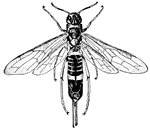
Ichneumon
This female parasitic wasp has a strong boring ovipositor for laying eggs in holes she drills in trees.
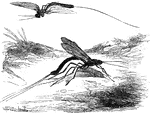
Ichneumon
"The ichineumons, with long ovipositors, as the European species, Ichneumon manifestator, seek…

Ichneumon Fly
Ichneumon flies are solitary insects, and most are parasitoids—the larvae feeding on or in another…
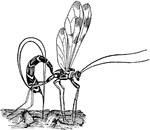
Ichneumon Fly
Ichneumon flies are solitary insects, and most are parasitoids—the larvae feeding on or in another…
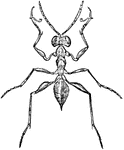
Ichneumon Fly
"Gonatopus contortulus. A genus of ichneumon-flies of the family Proctotrupidae and subfamily Dryininae,…
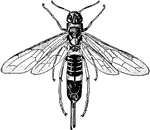
Pigeon Horntail
An insect known as the pigeon horntail (Tremex columba) deposits its eggs, by means of a strong, piercing…

Saw Fly (Lophyrus Pini)
"Another species which devours the leaves of pine trees. It represents another family of saw-flies."
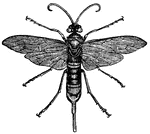
Saw Fly (Sirex Gigas)
"The insects of the genus Sirex belong to a species which lay their eggs in living wood, and…
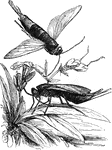
Sawfly
"On the continent of Europe the Sirex gigas often appears in immense numbers, and does great…
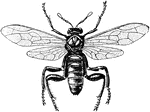
American Sawfly
The American Sawfly (Cimbex Americana) is an insect with an ovipositor resembling a saw blade.
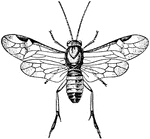
Larch Sawfly
The Larch Sawfly (Pristiphora erichsonii) is an insect resembling a black wasp in the Tenthredinidae…
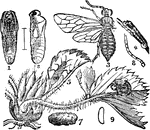
Strawberry Sawfly
"Strawberry False-worm (Emphytus maculatus). 1, 2 pupa, ventral and lateral views (line shows natural…
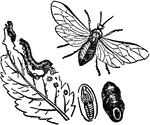
Turnip Sawfly
"Sawflies are a group of insects. The turnip fly and the gooseberry fly are examples."—(Charles…
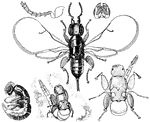
Wasp
This illustration shows a Blastophaga grossorum: a, adult female with wings extended, seen from above;…

Parasite Wasp Cocoon
The cocoon of Sigalphus curculionis, a species of parasitoid wasps. These insects use other insects…
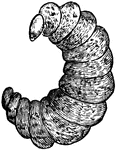
Parasite Wasp Larva
The larva of Sigalphus curculionis, a species of parasitoid wasps. These insects use other insects as…

Parasite Wasp Pupa
The pupa of Sigalphus curculionis, a species of parasitoid wasps. These insects use other insects as…
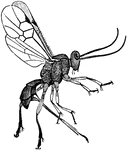
Female Adult Parasite Wasp
The female adult of Sigalphus curculionis, a species of parasitoid wasps. These insects use other insects…
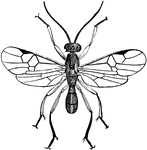
Male Adult Parasite Wasp
The male adult of Sigalphus curculionis, a species of parasitoid wasps. These insects use other insects…
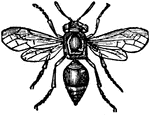
Card Making Wasp (Chartergus Nidulans)
"The Card Making Wasp of Cayenne is a consummate artist. From an architectural point of view, the card…

Chalcid Wasp
Eupelmus floridanus is a species of Chalcid wasp, a parasitic insect in the Eupelmidae family.
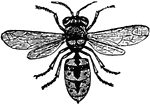
Common Wasp (Vespa Vulgaris)
"Wasps live in companies, which last only a year and are composed of males, females and workers. Their…
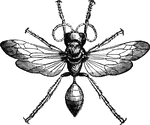
Digger Wasp
A popular name for wasps that burrow in the ground, in which th lay their eggs, provisioning each cell…
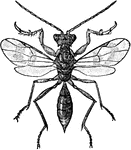
Embolimus Wasp
Embolimus americanus is a species of wasp belonging to the Proctotrupoidea superfamily of various wasps.

Dorsal View of Ensign Wasp
The dorsal view of the Ensign Wasp (Evania laevigata), an insect in the Evaniidae family.
